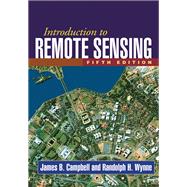Summary
A leading text for undergraduate- and graduate-level courses, this book introduces widely used forms of remote sensing imagery and their applications in plant sciences, hydrology, earth sciences, and land use analysis. The text provides comprehensive coverage of principal topics and serves as a framework for organizing the vast amount of remote sensing information available on the Web. Featuring case studies and review questions, the book's 4 sections and 21 chapters are carefully designed as independent units that instructors can select from as needed for their courses. Illustrations include 29 color plates and over 400 black-and-white figures. New to this edition: reflects significant technological and methodological advances chapter on aerial photography now emphasizes digital rather than analog systems updated discussions of accuracy assessment, multitemporal change detection, and digital preprocessing links to recommended online videos and tutorials. This book will be important reading for students in a variety of disciplines, including geography, forestry, hydrology, and planning; also of interest to professionals who utilize remotely sensed data. It will also be a core text for undergraduate- and graduate-level remote sensing courses.
Author Biography
James B. Campbell is Professor of Geography at Virginia Tech, where he teaches remote sensing, quantitative methods, and geomorphology. He has worked closely with students and faculty in related fields such as forestry, geology, agronomy, environmental sciences, and planning. Since 1997 he has served as Codirector of Virginia Tech\u2019s Center for Environmental Applications of Remote Sensing (CEARS). The author of numerous technical articles and several books, Dr. Campbell has received the Outstanding Service Award and the Fellow Award of the American Society for Photogrammetry and Remote Sensing. He is also a recipient of the Outstanding Service Medal awarded by the Remote Sensing Specialty Group of the Association of American Geographers. Dr. Campbell has been active in the AmericaView Program, including service as a principal investigator for the VirginiaView consortium and as a member and chair of the AmericaView Board of Directors.
Randolph H. Wynne is Professor in the Forest Resources and Environmental Conservation Department at Virginia Tech. He also serves as Remote Sensing Team Leader for the Forest Productivity Cooperative, Associate Director of the Conservation Management Institute, and Codirector of CEARS. He teaches courses in forest photogrammetry and spatial data processing and remote sensing of natural resources. Dr. Wynne\u2019s research interests are in the applications of remote sensing to forestry, natural resource management, ecology, ecosystem services, and earth system science.
Table of Contents
Part I. Foundations
1. History and Scope of Remote Sensing
2. Electromagnetic Radiation
Part II. Image Acquisition
3. Mapping Cameras
4. Digital Imagery
5. Image Interpretation
6. Land Observation Satellites
7. Active Microwave
8. Lidar
9. Thermal Imagery
10. Image Resolution
Part III. Analysis
11. Preprocessing
12. Image Classification
13. Field Data
14. Accuracy Assessment
15. Hyperspectral Remote Sensing
16. Change Detection
Part IV. Applications
17. Plant Sciences
18. Earth Sciences
19. Hydrospheric Sciences
20. Land Use and Land Cover
21. Global Remote Sensing
Conclusion. The Outlook for the Field of Remote Sensing: The View from 2011

